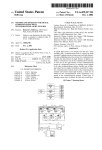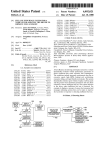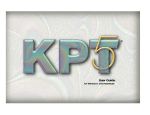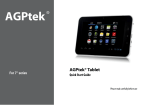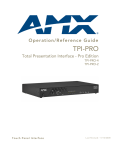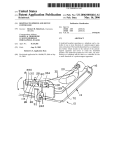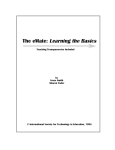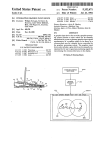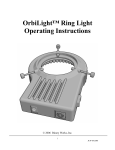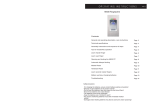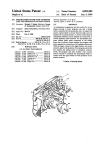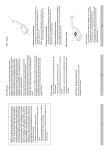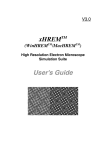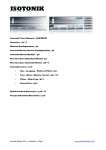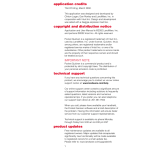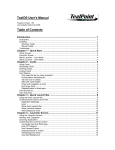Download Pushbutton optical screen pointing device
Transcript
US006809723B2 (12) United States Patent (10) Patent No.: Davis (54) US 6,809,723 B2 (45) Date of Patent: PUSHBUTTON OPTICAL SCREEN POINTING DEVICE FOREIGN PATENT DOCUMENTS JP 2001006509 A (75) Inventor: Je?'ery Davis, Mountain View, CA (Us) * 1/2001 ........ .. H01H/43/02 OTHER PUBLICATIONS “Seeing Eye” Mouse for a Computer System, US. patent (73) Assignee: Agilent Technologies, Inc., Palo Alto, CA (US) (*) Notice: Oct. 26, 2004 subject_to any disclaimer>_ the term of this application Ser. No. 09/052,046, ?led Mar. 30, 1998. Vince Lee, TEX Tennison, and Amanda Epume; TealDoc User’s Manual, Program Version 3.03; Nov. 15, 1999. Adobe Systems Incorporated; Adobe Acrobat Reader 4.0 patent is extended or adJusted under 35 Guide; 1999 U'S'C' 154(k)) by 245 days‘ (21) APPL N05 09/855,013 (22) Filed: May 14, 2001 LandWare, Inc., TakeNote! DOC and Memo Text Processor for Palm Connected Organizers; 2000. US. patent application Ser. No. 09/930,207, Hoshino et al., ?led Mar- 14> 2002 (65) * Cited by examiner Prior Publication Data US 2002/0167489 A1 Nov. 14, 2002 Primary Examiner—Kent Chang (51) Int. c1.7 ................................................ .. G09G 5/08 Assistant Ex“mi””_T°m Sheng (52) US. Cl. ...................... .. 345/166; 345/160; 345/165 (57) (58) Field of Search ....................... .. 345/163, 165—166, 345/169, 175, 160, 161 ABSTRACT An apparatus for controlling 'the position of a screen pointer for an electronic device having a display screen includes a (56) References Cited 5 578 813 A 5j644:139 A 11/1996 Allen et a1‘ 7/1997 Allen et a1‘ pushbutton for selecting an item displayed on the display screen. The pushbutton includes an imaging surface against Which a portion of the tip of a human digit may be placed. Alight source illuminates'that portion of the tip of the digit that is placed against the imaging surface, thereby generat 5’786’804 A 5’994’710 A 7/1998 Gordon 11/1999 Knee et a1_ ing re?ected images. The apparatus includes a motion trans ducer. A lens receives the re?ected images and directs the US. PATENT DOCUMENTS 6,005,490 A * 12/1999 Higashihara ,,,,,,,,, __ 340/:32572 re?ected images onto the motion transducer. The motion 6,057,540 A 6,151,015 A transducer generates digital representations of the re?ected images. The motion transducer generates a ?rst set of 5/2000 Gordon et al. 11/2000 Badyal et al- 6,336,727 B1 * 1/2002 Kim .......................... .. 362/23 6,670,946 B2 * 12/2003 End?“ a1‘ """""""" " 345/160 :1. ........... .. 2002/0135565 A1 * 9/2002 2003/0006965 A1 * 1/2003 Bohn ....................... .. 345/163 movement data based on the digital representations of the re?ected images. The ?rst set of movement data is indicative of of of Gordon et al. .... .. 13 Claims, 4 Drawing Sheets U.S. Patent 0a. 26, 2004 Sheet 1 of4 US 6,809,723 B2 U.S. Patent 0a. 26, 2004 Sheet 2 of4 US 6,809,723 B2 20 U.S. Patent 0a. 26, 2004 20\ Sheet 3 of4 42 US 6,809,723 B2 38 58 l / 40 46 23 50 36A 56 77 />< 8O __J \ 72 \ 44 76 Fig. 2B 80 U.S. Patent 196 i Oct. 26, 2004 10 I Sheet 4 0f 4 198 / US 6,809,723 B2 20 / > COMMUNICATION 14 / I I MOTION DETECTION DEVICE DISPLAY 200 24 I r V0 V0 INTERFACE INTERFACE <- KEYPAD 202/ 204 ( PROCESSOR 206 208 / / DRIVER <——* Fig. 3 MEMORY US 6,809,723 B2 1 2 PUSHBUTTON OPTICAL SCREEN POINTING DEVICE interest, a button on the mouse is activated With the ?ngers of the hand holding the mouse. The activation serves as an instruction to take some action, the nature of Which is de?ned by softWare in the computer. REFERENCE TO RELATED PATENTS In addition to mechanical types of pointing devices like a This application is related to the subject matter described in the following US. patents: US. Pat. No. 5,578,813, ?led Mar. 2, 1995, issued Nov. 26, 1996, and entitled FREE conventional mouse, optical pointing devices have also been developed, such as those described in the incorporated patents and patent application. In one form of an optical pointing device, rather than using a moving mechanical HAND IMAGE SCANNING DEVICE WHICH COMPEN SATES FOR NON-LINEAR MOVEMENT; US. Pat. No. 5,644,139, ?led Aug. 14, 1996, issued Jul. 1, 1997, and 10 entitled NAVIGATION TECHNIQUE FOR DETECTING MOVEMENT OF NAVIGATION SENSORS RELATIVE TO AN OBJECT; and US. Pat. No. 5,786,804, ?led Oct. 6, desktop, and photo detectors Within the optical pointing 1995, issued Jul. 28, 1998, and entitled METHOD AND SYSTEM FOR TRACKING ATTITUDE. These three pat 15 cameras, portable game devices, pagers, portable music players (e.g., MP3 players), and other devices, it may be Those techniques are a component in a preferred embodi ment described beloW. Accordingly, US. Pat. Nos. 5,578, 20 AND POSITION TRANSLATION TYPE SCREEN 25 POINTER CONTROL FOR A COMPUTER SYSTEM; US. Pat. No. 6,151,015, ?led Apr. 27, 1998, issued Nov. 21, 30 to highlight and select menu items is inef?cient and time Some portable electronic devices also include indicators, COMPUTER SYSTEM, are hereby incorporated herein by such as blinking lights or audible indicators, to provide some type of noti?cation to a user, such as a noti?cation that the user has received an email message or voicemail message. THE FIELD OF THE INVENTION 40 This invention relates generally to devices for controlling BACKGROUND OF THE INVENTION For example, some telephones include a blinking light to notify the user that the user has received a voicemail a cursor on a display screen, also knoWn as pointing devices. optical pointing device. highlighted, the menu item is typically selected by pressing another key on the cellular telephone. Using multiple keys consuming, particularly for users Who are more familiar With operating other types of screen pointing devices, such as a 35 mouse or trackball, or an optical pointing device. reference. This invention relates more particularly to a pushbutton Some portable electronic devices include built-in screen pointing devices. For example, some cellular telephones around on a display screen to highlight menu items, such as names or telephone numbers. Once a menu item has been DEVICE; and US. patent application Ser. No. 09/052,046, ?led Mar. 30, 1998, entitled SEEING EYE MOUSE FOR A mouse, it may be dif?cult to ?nd a suitable surface on Which to operate the mouse. include arroW keys that alloW a highlight bar to be moved 2000, and entitled PEN LIKE COMPUTER POINTING the techniques described in US. Pat. Nos. 5,578,813, 5,644, 139, and 5,786,804. Therefore, US. Pat. Nos. 6,057,540 and 6,151,015, and US. patent application Ser. No. 09/052,046, undesirable to use an external pointing device, such as a mechanical mouse or an optical mouse, coupled to the device. It is often inconvenient to carry around the additional equipment. And With a mechanical pointing device like a This application is also related to the subject matter described in US. Pat. No. 6,057,540, ?led Apr. 30, 1998, issued May 2, 2000, and entitled MOUSELESS OPTICAL ?led Mar. 30, 1998, entitled SEEING EYE MOUSE FOR A COMPUTER SYSTEM. These tWo related patents and patent application describe screen pointing devices based on device, is optically sensed and converted into movement information. For portable electronic devices, such as cellular telephones, personal digital assistants (PDAs), digital ents describe techniques of tracking position movement. 813, 5,644,139, and 5,786,804 are hereby incorporated herein by reference. element like a ball in a conventional mouse, relative move ment betWeen an imaging surface, such as a ?nger or a message. Such indicators are typically provided by a stan dalone LED on the device, on a display screen of the device, or by an audio subsystem, and are not incorporated into a 45 screen pointing device. It Would be desirable to provide an optical screen pointing device for use in a portable electronic device that combines The use of a hand operated pointing device for use With a computer and its display has become almost universal. By screen pointer motion control, selection capabilities, and far the most popular of the various devices is the conven tional (mechanical) mouse, used in conjunction With a indication functions into a single compact device. cooperating mouse pad. Centrally located Within the bottom SUMMARY OF THE INVENTION surface of the mouse is a hole through Which a portion of the underside of a rubber-surfaced steel ball extends. The mouse One form of the present invention provides an apparatus for controlling the position of a screen pointer for an electronic device having a display screen. The apparatus includes a pushbutton for selecting an item displayed on the display screen. The pushbutton includes an imaging surface against Which a portion of the tip of a human digit may be pad is typically a closed cell foam rubber pad covered With a suitable fabric. LoW friction pads on the bottom surface of the mouse slide easily over the fabric, but the rubber ball does not skid. Rather, the rubber ball rolls over the fabric as 55 placed. A light source illuminates that portion of the tip of the mouse is moved. Interior to the mouse are rollers, or the digit that is placed against the imaging surface, thereby Wheels, that contact the ball at its equator and convert its rotation into electrical signals representing orthogonal com 60 ponents of mouse motion. These electrical signals are coupled to a computer, Where softWare responds to the signals to change by a AX and a AY the displayed position of a pointer (cursor) in accordance With movement of the mouse. The user moves the mouse as necessary to get the 65 displayed pointer to a desired location or position. Once the pointer on the screen points at an object or location of generating re?ected images. The apparatus includes a motion transducer. A lens receives the re?ected images and directs the re?ected images onto the motion transducer. The motion transducer generates digital representations of the re?ected images. The motion transducer generates a ?rst set of movement data based on the digital representations of the re?ected images. The ?rst set of movement data is indicative of motion of the tip of the digit across the imaging surface. US 6,809,723 B2 4 3 Cellular telephone 10 includes poWer button 12, display Another form of the present invention provides a method of controlling the position of a screen pointer for an elec tronic device having a display screen. A pushbutton for selecting an item displayed on the display screen is pro vided. A portion of an appendage of the human hand is screen 14, highlight bar 16, menu items 18A—18C (collectively referred to as menu 18), motion detection device 20, and a plurality of pushbuttons 24. Pushbuttons 24 are also referred to as keypad 24. Motion detection device 20 includes indicator ring 21 and pushbutton 23. A user turns cellular telephone 10 on/off using poWer button 12. A menu 18, including a plurality of menu items 18A—18C, is dis placed against the pushbutton. A portion of the appendage that is against the pushbutton is illuminated. Images re?ected from the portion of the appendage are focused onto an array of photo detectors. Output values of the photo played to a user on display screen 14. In one embodiment, detectors are digitiZed, thereby generating digital represen 10 menu items 18A—18C are names or phone numbers. For menu items 18A—18C that are names, cellular telephone 10 tations of the re?ected images. At least one version of a ?rst stores an associated telephone number for each such name. one of the digital representations is correlated With at least Although one embodiment of the present invention is one version of a second one of the digital representations to generate a ?rst set of motion data indicative of motion in orthogonal aXes across the pushbutton by the appendage. The position of the screen pointer is adjusted in accordance described in the conteXt of a menu 18 and a highlight bar 16, 15 selectable items (e.g., selectable icons) that are individually With the ?rst set of motion data. identi?ed by placing the movable screen pointer over a desired item. Another form of the present invention provides a portable electronic device including a display screen for displaying a plurality of selectable items and a pointer movable by a user to identify particular ones of the selectable items. A motion sensing pushbutton senses movement across the pushbutton A user highlights a particular one of the menu items 18A—18C by moving highlight bar 16. In one embodiment, highlight bar 16 is moved by rubbing ?nger 22 against motion detection device 20, and more particularly against by an imaging surface. The pushbutton is con?gured to generate a ?rst set of movement data indicating a ?rst movement of the imaging surface across the pushbutton, and alternative embodiments use other display arrangements, such as a movable screen pointer (e.g., an arroW) and 25 pushbutton 23. If ?nger 22 is moved upWard against motion detection device 20, highlight bar 16 moves upWard through is con?gured to generate a selection signal When pushed by menu items 18A—18C. If ?nger 22 is moved doWnWard a user. A controller is con?gured to move the pointer based on the ?rst set of movement data to identify a ?rst selectable item. The controller is con?gured to select the ?rst menu doWnWard through menu items 18A—18C. After a desired one of the menu items 18A—18C has been highlighted With against motion detection device 20, highlight bar 16 moves highlight bar 16, the highlighted menu item is then selected. item based on the selection signal generated by the push In one embodiment, a highlighted menu item is selected by button. pushing doWn on pushbutton 23 With ?nger 22. In one form of the invention, after a highlighted menu item has been BRIEF DESCRIPTION OF THE DRAWINGS FIG. 1 is a perspective vieW of a cellular telephone With an optical, pushbutton screen pointer device according to 35 With the selected name. one embodiment of the present invention. FIG. 2A is an eXploded vieW illustrating the main com ponents of one embodiment of an optical, pushbutton screen pointer device according to the present invention. FIG. 2B is a cross-sectional vieW taken along section lines 2B—2B in FIG. 2A illustrating the screen pointer device shoWn in FIG. 2A after assembly. FIG. 3 is an electrical block diagram of major components of the cellular telephone shoWn in FIG. 1. selected by a user, cellular telephone 10 automatically dials the selected phone number, or the phone number associated In addition to performing item selection, motion detection device 20 may be used to perform a variety of other functions, depending upon the particular type of portable 40 electronic device that motion detection device 20 is used in. Such uses include, but are not limited to, moving a screen 45 DESCRIPTION OF THE PREFERRED EMBODIMENTS pointer around a display screen and selecting displayed items in virtually any type of device, causing a picture to be taken in a portable camera, and causing video and/or sound recording to begin in a recording device. In one embodiment, pushbutton 23 lights up When touched by a user. In one form of the present invention, pushbutton 23 also lights up to provide some type of In the folloWing detailed description of the preferred noti?cation to a user, such as a noti?cation that the user has received an email message or voicemail message, a noti? embodiments, reference is made to the accompanying draWings, Which form a part hereof, and in Which is shoWn by Way of illustration speci?c embodiments in Which the invention may be practiced. It is to be understood that other cation of an incoming call, or other noti?cation. In one embodiments may be utiliZed and structural or logical lights up to provide some type of noti?cation to a user. changes may be made Without departing from the scope of embodiment, motion detection device 20 includes indicator ring 21, Which surrounds pushbutton 23, and Which also 55 Motion detection device 20 may be con?gured to provide a the present invention. The folloWing detailed description, variety of different noti?cations With pushbutton 23 and therefore, is not to be taken in a limiting sense, and the scope indicator ring 21, by causing pushbutton 23 and/or indicator of the present invention is de?ned by the appended claims. ring 21 to blink together or separately, to blink at different FIG. 1 is a perspective vieW of a portable electronic device 10 With an optical, pushbutton screen pointer device 20 according to one embodiment of the present invention. In rates, or to emit different colors of visible light. In one the embodiment shoWn in FIG. 1, portable electronic device 10 is a cellular telephone. In an alternative embodiment, device 10 may be any type of portable electronic device having a display screen, including a personal digital assis tant (PDA), digital camera, portable game device, pager, portable music player, or other device. embodiment, each type of visual indication provided by pushbutton 23 and indicator ring 21 correspond to a par ticular type of noti?cation. For example, indicator ring 21 could blink tWo times in quick succession, pause for a brief period of time, and then blink tWo times in quick succession, 65 and so on, to indicate that the user has 2 voicemail messages. Pushbutton 23 could blink in similar manner to indicate the number of received email messages. US 6,809,723 B2 5 6 FIG. 2A is an exploded vieW illustrating the main com ponents of one embodiment of a motion detection device 20 skin and any other micro texture features are visible in the plane of surface 38, just as if they Were a part of surface 38. Lens 58 focuses light from those features onto an array of photo detectors 77, Which is part of movement sensor 76. Movement sensor 76 automatically acquires and tracks any suitable image. When tracking an image, movement sensor according to the present invention. Motion detection device 20 includes outer mechanical frame 23, lens assembly 40, internal mechanical frame 50, and circuit assembly 70. Outer mechanical frame 23 acts as a pushbutton as described in further detail beloW, and is also referred to as pushbutton 23. Outer mechanical frame 23 includes cylindrical frame 32 and ?ngers 36A and 36B. Fingers 36A—36B are attached to an outer surface of cylindrical frame 32 and eXtend generally 76 produces incremental (X, Y) signals. In one embodiment, in addition to illuminating an imag ing or Work surface, such as ?nger 22, for purposes of 10 doWnWard. Atop surface of cylindrical frame 32 is generally concave in shape, and is covered by top cover 38, as can be better seen in FIG. 2B. Hole 34 is formed in cylindrical the user. In alternative embodiments, an additional LED or multiple LEDs, including different colored LEDs, are used to emit visible light through surface 38 to provide indica frame 32 near the center of the frame. Lens assembly 40 includes top portion 42, bottom portion 44, and middle portion 46. Top portion 42 of lens assembly 15 tions or noti?cations. Lifting the ?ngertip aWay from surface 38 by even a feW thousandths of an inch defocuses the image and produces a loss of tracking. This condition is detected Within motion 40 is generally circular in shape, and ?ts Within hole 34 of cylindrical frame 32 When assembled. Middle portion 46 of lens assembly 40 is substantially holloW, and is angled With detector 76, and in one embodiment, the production of incremental (X, Y) signals ceases. This has the effect of leaving highlight bar 16 unchanged at Whatever location it respect to bottom portion 44, as can be better seen in FIG. 2B. Bottom portion 44 of lens assembly 40 is generally cylindrical in shape. currently occupies, and is eXactly the same as When a user Internal mechanical frame 50 includes opening 52, col of a mouse removes his hand from the mouse. When the umns 54, recess 56, and lens 58. Recess 56 is formed on a top surface of internal mechanical frame 50, and is shaped 25 to partially conform to an outer surface of cylindrical frame 32. Opening 52 is formed near the center of a top surface of coordinates (X, Y) Will have the value (0, 0). This leaves the eXisting position of highlight bar 16 undisturbed until such assembly 40 is positioned Within opening 52, and outer time as it is deliberately moved by the motion of the ?ngertip, and corresponds exactly to a mouse user’s place mechanical frame 23 is positioned over recess 56, as shoWn in FIG. 2B. Lens 58 is positioned Within opening 52 of internal mechanical frame 50. Four columns 54 are attached to a bottom surface of internal mechanical frame 50, and are used to attach internal mechanical frame 50 to circuit ment of his hand back on the mouse Without moving it. Motion sensor 76 uses eXactly or substantially the same technique as the imaging and navigation arrangement described in the incorporated Patents. In the particular operational settings described therein, it Was desirable that there be some magni?cation of the image before it reached assembly 70. Circuit assembly 70 includes light emitting diode (LED) 72, motion sensor 76, printed circuit board (PCB) 80, and support chips 82. LED 72, motion sensor 76, and support 40 center of PCB 80, and is generally cylindrical in shape to to an outer surface of columns 54 of internal mechanical the sensor, because of the small siZe of the micro-features being imaged and tracked (e.g., paper ?bers). Here, the features on the ?ngertip are really quite large in comparison, conform to an outer surface of bottom portion 44 of lens assembly 40. Recesses 78 are formed near the corners of PCB 80, and are generally cylindrical in shape to conform ?ngertip is subsequently replaced on surface 38, motion detector 76 appreciates that an image has been acquired, and, in one embodiment, treats that acquisition as though a reset has been performed. That is, until there has been neW motion subsequent to the neW acquisition, the incremental internal mechanical frame 50, and is shaped to conform to an outer surface of lens assembly 40. When assembled, lens chips 82 are attached to PCB 80. Hole 74 is formed near the motion detection, LED 72 also emits visible light through surface 38 to provide a type of indication or noti?cation to so that magni?cation is not used in one embodiment. Even 45 frame 50. When assembled, columns 54 of internal mechani though one form of an imaging and navigation mechanism is described in the incorporated Patents, a brief overvieW of the technique is provided beloW. LED 72, Which is an IR LED in one embodiment, emits cal frame 50 are positioned Within recesses 78 of circuit light that is projected by lens assembly 40 onto a region 38 assembly 70, and bottom portion 44 of lens assembly 40 is that is part of a Work surface to be imaged for navigation. In positioned Within hole 74, as shoWn in FIG. 2B. one form of the present invention, motion sensor 76 is an Indicator ring 21 (shoWn in FIG. 1) is not shoWn in FIGS. 2A and 2B, but in one embodiment, is placed around the integrated circuit (IC) having an array of photo detectors 77, memory, and arithmetic circuits arranged to implement image correlation and tracking functions described herein and in the incorporated patents. An image of the illuminated region, such as an image of the ?ngertip of ?nger 22, is outer perimeter of cylindrical frame 32, and is electrically coupled to circuit assembly 70. FIG. 2B is a cross-sectional vieW taken along section lines 2B—2B in FIG. 2A illustrating the motion detection device 20 shoWn in FIG. 2A after assembly. As shoWn in FIG. 2B, 55 pushbutton 23 is rotated 180 degrees about its cylindrical aXis from the position shoWn in FIG. 2A. Motion detection projected through an optical WindoW to a package of inte grated circuit 76 and onto the array of photo detectors 77. Lens 58 aids in the projection of the image onto the photo detectors. device 20 tracks the movement of a Work surface or an One preferred optical navigation technique according to imaging surface, such as human ?nger 22, Which is pressed against top cover 38 of pushbutton 23. LED 72 emits light that is gathered and focused by lens assembly 40 to illuminate top portion 42 of lens assembly 40 the present invention optically detects motion by directly and top cover 38. Top cover 38 may be a glass or other Wear 65 imaging as an array of piXels the various particular optical features visible at surface 38, much as human vision is believed to do. IR light re?ected from a teXtured Work surface pressed against surface 38 is focused onto a suitable resistant layer applied to the top of pushbutton 23. When the array (e.g., 16x16 or 24x24) of photo detectors 77. The tip of ?nger 22 is pressed against surface 38, the ridges of responses of the individual photo detectors are digitiZed to US 6,809,723 B2 7 8 a suitable resolution (e.g., six or eight bits) and stored as a frame into corresponding locations Within an array of memory. In one embodiment, each pixel in a frame corre sponds to one of the photo detectors. The overall siZe of the array of photo detectors 77 is more than four pixels per cycle, a measurement rate of 200 samples per second is needed. This rate is quite practical, and it may be desirable to operate at several times this rate. As shoWn in FIG. 2B, pushbutton 23 is positioned over recess 56 of internal mechanical frame 50, and ?nger 36A of pushbutton 23 extends through PCB 80. In one embodiment, PCB 80 is attached to a main printed circuit board (not preferably large enough to receive an image having several features (e.g., ridges in the Whorls of skin). In this Way, images of such spatial features produce translated patterns of shoWn) of portable electronic device 10, and ?nger 36A is positioned over a button or dome on the main printed circuit pixel information as the ?ngertip moves. The number of photo detectors in the array and the frame rate at Which their contents are digitiZed and captured cooperate to in?uence hoW fast the ?ngertip can be moved over surface 38 and still board. Recess 56 alloWs pushbutton 23 to ?ex When pushed by a user, Which causes ?nger 36A of pushbutton 23 to move doWnWard through PCB 80 and actuate a button on the main printed circuit board. FIG. 3 is an electrical block diagram illustrating the major be tracked. Tracking is accomplished by comparing a neWly captured sample frame With a previously captured reference components of a portable electronic device 10, such as frame to ascertain the direction and amount of movement. 15 cellular telephone. Portable electronic device 10 includes In one embodiment, the entire content of one of the antenna 196, communications circuitry 198, motion detec frames is shifted by a distance of one pixel successively in each of the eight directions alloWed by a one pixel offset trial tion device 20, display 14, input/output (I/O) interface 200, I/O interface 202, keypad 24, processor 204, and memory 206. Motion detection device 20, display 14, and keypad 24 shift (one over, one over and one doWn, one doWn, one up, one up and one over, one over in the other direction, etc.). That adds up to eight trials. Also, since there might not have are each coupled to I/O interface 202. I/O interface 202 is also coupled to processor 204. Processor 204 communicates been any motion, a ninth trial “null shift” is also used. After With motion detection device 20, display 14, and keypad 24, each trial shift, those portions of the frames that overlap each other are subtracted on a pixel by pixel basis, and the resulting differences are preferably squared and then 25 memory 206. Processor 204 uses driver 208 to control highlight bar 16 on display 14 based on movement data received from motion sensor 76 Within motion detection device 20. Communications are sent and received by device 10 via antenna 196. Antenna 196 is coupled to communications summed to form a measure of similarity (correlation) Within that region of overlap. Larger trial shifts are possible, of course (e.g., tWo over and one doWn), but at some point the attendant complexity ruins the advantage, and it is prefer able to simply have a suf?ciently high frame rate With small trial shifts. The trial shift With the least difference (greatest circuitry 198. Communications circuitry 198 includes stan correlation) can be taken as an indication of the motion dard communications components knoWn to those of ordi nary skill in the art, such as ampli?ers, analog-to-digital betWeen the tWo frames. That is, it provides raW movement information that may be scaled and or accumulated to provide highlight bar movement information (AX and AY) 35 of a convenient granularity and at a suitable rate of infor Sensor 76 automatically detects When the ?ngertip has majority of the pixels in the image have “gone dark.” The receives incremental (X, Y) signals from motion sensor 76 40 Within motion detection device 20, indicating relative move ment betWeen motion detection device 20 and a Work process is actually someWhat more complicated than that, as surface. Processor 204 also receives selection signals from motion detection device 20, indicating that a user has pushed explained beloW. When the ?ngertip is removed from surface 38, the IR light from the illuminating LED 72 no longer reaches the photo detectors in the same quantity that it did previously, if converters, digital-to-analog converters, modulators, and demodulators. Processor 204 is coupled to communications circuitry 198 via I/O interface 200. In one form of the present invention, processor 204 mation exchange. been removed from surface 38, by sensing that all or a via I/O interface 202. Processor 204 is also coupled to memory 206. In one embodiment, driver 208 is stored in 45 at all; the re?ecting surface is too far aWay or is simply not in vieW. HoWever, if the ?ngertip is removed and the surface 38 is exposed to an intensely lit environment as a result, then pushbutton 23. Using driver 208, processor 204 processes the received incremental (X, Y) signals and selection signals, and takes appropriate action. For example, if ?nger 22 is moved upWard against motion detection device 20, processor 204 receives incremental (X, Y) signals from the outputs of the photo detectors might be at any level. The key is that the outputs of the photo detectors Will be uniform, motion sensor 76 indicative of this upWard movement. In response, processor 204 causes highlight bar 16 on display 14 to move upWard through menu items 18A—18C. If ?nger or nearly so. The main reason that the outputs become 22 is moved doWnWard against motion detection device 20, uniform is that there is no longer a focused image. All of the image features are indistinct and they are each spread out over the entire collection of photo detectors. Therefore, the photo detectors uniformly come to some average level. This processor 204 receives incremental (X, Y) signals from 55 is in distinct contrast With the case When there is a focused received selection signals from motion detection device 20 indicate that a user has pressed pushbutton 23, processor 204 causes communications circuitry 198 to dial the phone number associated With the currently highlighted menu item. In one embodiment, the speed of movement of highlight bar image. In the focused case, the correlations betWeen frames (recall the one over, one over and one doWn, etc.) exhibit a distinct phenomenon. In operation, images should be acquired at a rate suf?cient that successive images differ in distance by no more that perhaps a quarter of the Width of the array, or 4 pixels for a 16x16 array of photo sensors. Experiments shoW that a ?nger speed of 50 mm/sec is not unreasonable. With 1:1 imaging, this corresponds to a speed at the array of 800 pixels per second. To meet a requirement of not moving motion sensor 76 indicative of this doWnWard movement. In response, processor 204 causes highlight bar 16 on display 14 to move doWnWard through menu items 18A—18C. If the 16 or other screen pointer is programmable by a user. Processor 204 also transmits indicator light control sig nals to motion detection device 20 via I/O interface 202. The 65 indicator light control signals control the lighting of indica tor ring 21 and pushbutton 23 to provide various noti?ca tions to the user. US 6,809,723 B2 10 In one form of the present invention, a user may enter free 3. The apparatus of claim 2, Wherein the apparatus is hand drawings into portable electronic device 10 by moving con?gured to emit visible light through the pushbutton When the pushbutton is touched. 4. The apparatus of claim 2, Wherein the apparatus is con?gured to emit visible light through the pushbutton to ?nger 22 against motion detection device 20. Entered draW ings may be used to annotate or create facsimile documents, or may represent user signatures that may be used to verify provide a noti?cation to the user. electronic transactions. In addition, character recognition softWare may be used to recogniZe alphanumeric character symbols entered by a user by moving ?nger 22 against motion detection device 20. It Will be understood by a person of ordinary skill in the 5. The apparatus of claim 2, Wherein the apparatus is con?gured to emit visible light through the pushbutton in short bursts, thereby causing the pushbutton to appear to 1O art that functions performed by portable electronic device 10 may be implemented in hardWare, softWare, ?rmWare, or any combination thereof. The implementation may be via a 7. The apparatus of claim 6, Wherein each color of visible 15 softWare on one or more computer-readable mediums. The term computer-readable medium as used herein is de?ned to include any kind of memory, volatile or non-volatile, such as embodiment, it Will be appreciated by those of ordinary skill 25 scope of the present invention. Those With skill in the chemical, mechanical, electromechanical, electrical, and tion may be implemented in a very Wide variety of embodi ments. This application is intended to cover any adaptations or variations of the preferred embodiments discussed herein. Therefore, it is manifestly intended that this invention be pointer for an electronic device having a display screen, the method comprising: limited only by the claims and the equivalents thereof. 35 pushbutton; 40 age onto an array of photo detectors; digitiZing output values of the photo detectors, thereby generating digital representations of the re?ected surface against Which a portion of the tip of a human images; a light source for illuminating that portion of the tip of the 45 a motion transducer; correlating at least one version of a ?rst one of the digital representations With at least one version of a second one of the digital representations to generate a ?rst set of motion data indicative of motion in orthogonal aXes across the pushbutton by the appendage; adjusting the position of the screen pointer in accordance With the ?rst set of motion data; a lens for receiving the re?ected images and directing the re?ected images onto the motion transducer, the motion transducer generating digital representations of the re?ected images, the motion transducer generating a generating a second set of motion data indicative of motion in orthogonal aXes across the pushbutton by the ?rst set of movement data based on the digital repre sentations of the re?ected images, the ?rst set of movement data indicative of motion of the tip of the digit across the imaging surface; and against the pushbutton; focusing images re?ected from the portion of the append digit may be placed; digit that is placed against the imaging surface, thereby generating re?ected images; providing a pushbutton for selecting an item displayed on the display screen; placing a portion of an appendage of the human hand illuminating a portion of the appendage that is against the apparatus comprising: display screen, the pushbutton including an imaging is con?gured to emit visible light. 10. The apparatus of claim 9, Wherein the indicator device is con?gured to emit visible light in short bursts, thereby appearing to blink. 11. The apparatus of claim 9, Wherein the indicator device is con?gured to emit visible light in multiple colors. 12. The apparatus of claim 11, Wherein each color of visible light emitted by the indicator device corresponds to a type of noti?cation. 13. A method of controlling the position of a screen computer arts Will readily appreciate that the present inven a pushbutton for selecting an item displayed on the of noti?cation. 8. The apparatus of claim 1, and further comprising an indicator device substantially surrounding the pushbutton only memory (ROM), and random access memory. Although speci?c embodiments have been illustrated and described herein for purposes of description of the preferred What is claimed is: 1. An apparatus for controlling the position of a screen pointer for an electronic device having a display screen, the light emitted through the pushbutton corresponds to a type for providing a noti?cation. 9. The apparatus of claim 8, Wherein the indicator device ?oppy disks, hard disks, CD-ROMs, ?ash memory, read in the art that a Wide variety of alternate and/or equivalent implementations may be substituted for the speci?c embodi ments shoWn and described Without departing from the 6. The apparatus of claim 2, Wherein the apparatus is con?gured to emit visible light in multiple colors through the pushbutton. microprocessor, programmable logic device, or state machine. Components of the present invention may reside in blink. appendage; and 55 displaying information on the display screen correspond ing to the second set of motion data, Wherein the a frame for housing the light source, the motion information displayed on the display screen corre transducer, and the lens, and Wherein the pushbutton is sponding to the second set of motion data is an alpha numeric character. moveably positioned over a top surface of the frame. 2. The apparatus of claim 1, Wherein the apparatus is con?gured to emit visible light through the pushbutton.













